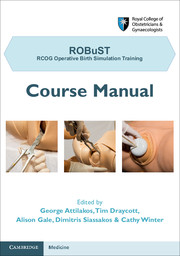Crossref Citations
This Book has been
cited by the following publications. This list is generated based on data provided by Crossref.
O’Brien, Stephen
Hotton, Emily J.
Lenguerrand, Erik
Wade, Julia
Winter, Cathy
Draycott, Tim J.
and
Crofts, Joanna F.
2019.
The ASSIST Study - The BD Odon Device for assisted vaginal birth: a safety and feasibility study.
Trials,
Vol. 20,
Issue. 1,
O’Brien, Stephen
Lenguerrand, Erik
Jordan, Sharon
Cornthwaite, Katie
Burden, Christy
Timlin, Laura
and
Siassakos, Dimitrios
2019.
Simulation TRaining for Operative vaginal Birth Evaluation: study protocol for an observational stepped-wedge interrupted time-series study (STROBE).
BMC Pregnancy and Childbirth,
Vol. 19,
Issue. 1,
van der Scheer, Jan W
Cornthwaite, Katie
Hewitt, Pauline
Bahl, Rachna
Randall, Wendy
Powell, Alison
Ansari, Akbar
Attal, Bothaina
Willars, Janet
Woodward, Matthew
Brown, Imogen A F
Olsson, Annabelle
Richards, Natalie
Price, Evleen
Giusti, Alessandra
Leeding, Joann
Hinton, Lisa
Burt, Jenni
Dixon-Woods, Mary
Maistrello, Giulia
Fahy, Nick
Lyons, Oscar
and
Draycott, Tim
2023.
Training for managing impacted fetal head at caesarean birth: multimethod evaluation of a pilot.
BMJ Open Quality,
Vol. 12,
Issue. 3,
p.
e002340.
Achiron, Reuven
Adamo, Laura
and
Weissbach, Tal
2023.
Practical Guide to Simulation in Delivery Room Emergencies.
p.
3.
Cornthwaite, Katie
Draycott, Tim
Winter, Cathy
Lenguerrand, Erik
Hewitt, Pauline
and
Bahl, Rachna
2023.
Validation of a novel birth simulator for impacted fetal head at cesarean section: An observational simulation study.
Acta Obstetricia et Gynecologica Scandinavica,
Vol. 102,
Issue. 1,
p.
43.
Al Wattar, Bassel H.
and
Parry‐Smith, William
2024.
International collaboration is needed to preserve the use of Kielland's forceps in modern obstetrics.
BJOG: An International Journal of Obstetrics & Gynaecology,
Vol. 131,
Issue. 8,
p.
1161.
Bahl, Rachna
Hotton, Emily
Crofts, Joanna
and
Draycott, Tim
2024.
Assisted vaginal birth in 21st century: current practice and new innovations.
American Journal of Obstetrics and Gynecology,
Vol. 230,
Issue. 3,
p.
S917.



